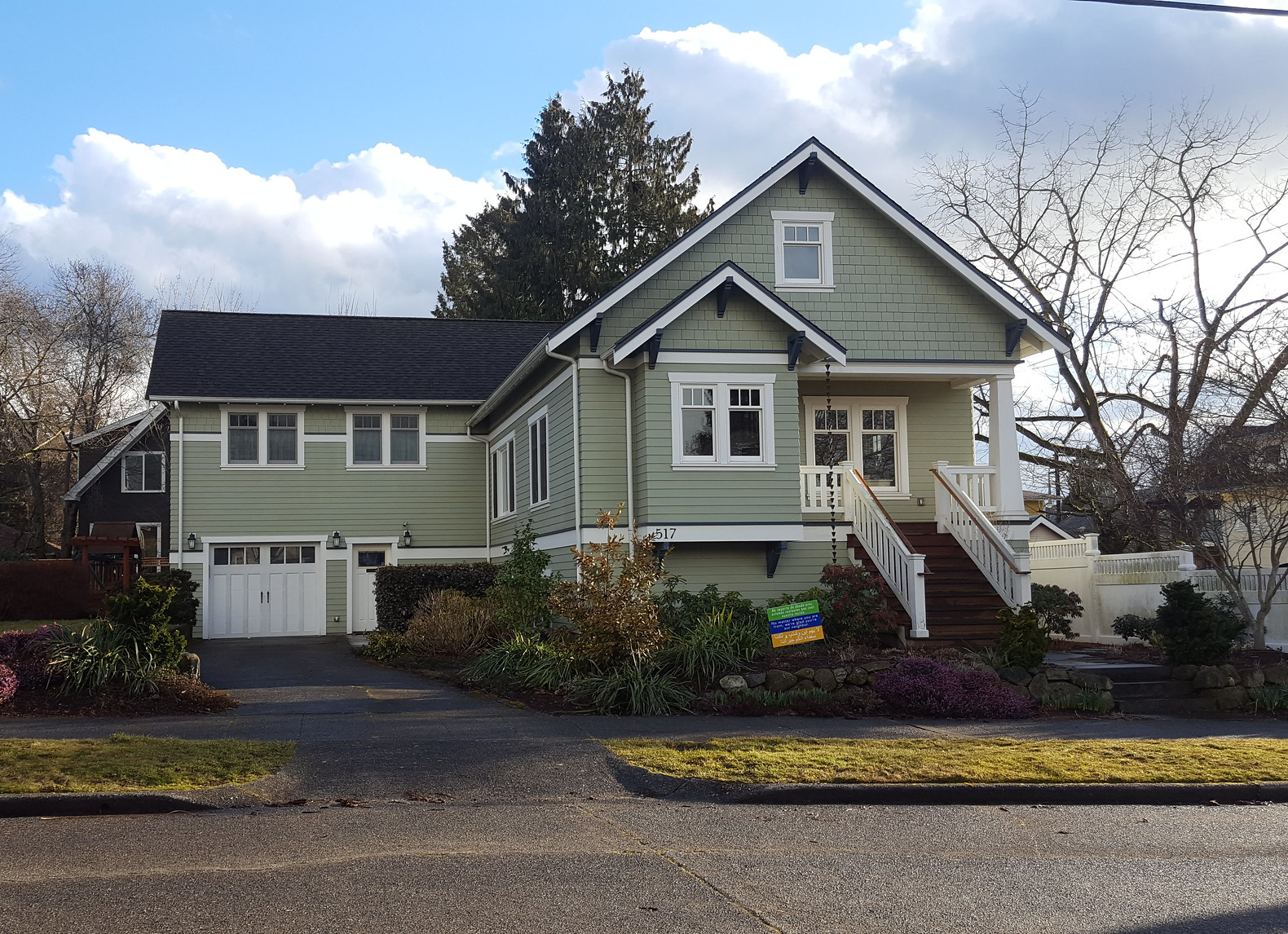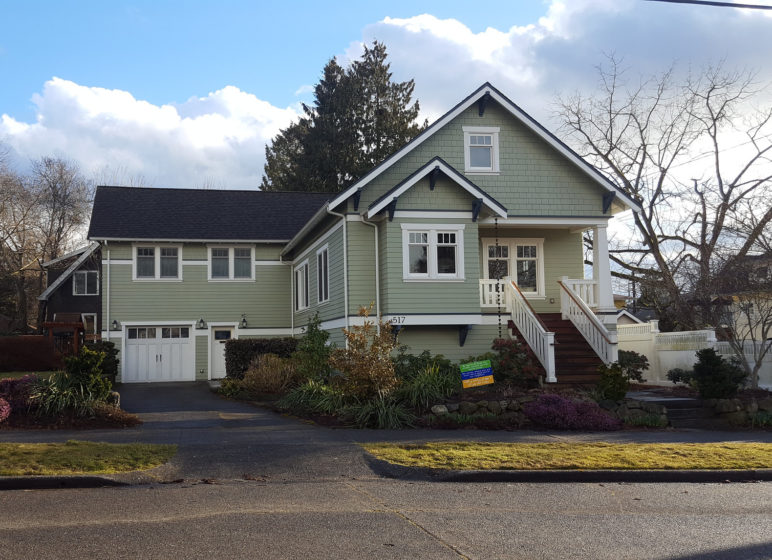Granny flats won in Olympia this session. Yesterday, Washington lawmakers took action to address the state’s housing shortage, leading cities in a unified effort to curb home prices and congestion by allowing more homes of all shapes and sizes.
Lawmakers passed SB 6617, waiving off-street parking requirements for backyard cottages, granny flats, and daylight basement apartments near frequent transit. Legislators haven’t required cities to legalize more housing so explicitly since 1993, the last time Washington passed accessory dwelling unit (ADU) legislation.
The bill, sponsored by Senators Liias (D-Lynnwood) and Das (D-Kent), and championed in the House by Representatives Fitzgibbon (D-Burien), Gregerson (D-Seatac), and Barkis (R-Olympia), will head to Governor Inslee’s desk for his signature later this month.
Accessory dwelling homes provide flexible housing choices for people at all stages of life, from young professionals to aging parents.

Accessory dwellings provide flexible housing choices for people at all stages of life, from young professionals to aging parents. The small homes tuck neatly into existing neighborhoods and their modest size reduces per capita home energy use. Diversifying home choices in existing neighborhoods also expands access to public gems, like local parks, community centers, and great schools, a move which makes all the more sense at a time when shrinking household size means many neighborhoods have fewer residents today than they did 50 years ago.
A significant move: People—and homes—over parking
The bill prohibits cities from imposing off-street parking requirements for ADUs within one-quarter mile of frequent transit, including commuter rail, rapid transit buses, or other public transportation that runs every 15 minutes or more during peak hours. Cities can prove extenuating circumstances, such as limited street space, to maintain parking mandates in specific areas.
Off-street parking requirements can add steep cost and complication to ADU home construction. Yet nearly every city in Washington imposes these rules, demanding homeowners section off large chunks of their lots for cars if they want to add one of these modest homes. Not only do the rules perpetuate car dependence and increase the cost of housing, they are also unnecessary in most neighborhoods, where ample street parking exists. Parking mandates make it impossible to build ADUs on many small or oddly shaped lots; even when space exists, many homeowners may balk at sacrificing yard space to make room for more car storage.
Legislators stripped the bill down considerably from its original form, which would have widened the no off-street parking buffers to one-half mile around transit stops with service at least twice per hour. A second, even stronger, ADU bill considered in the House, HB 2570, passed out of committee on a 10-1 vote but never made it to the floor for a vote. The main opposition to both bills came from legislators and stakeholders who believe that the state has no business setting rules on local land use. Sightline advised on the architecture of both ADU bills this session.
A groundswell of progress on ADUs
ADUs are en vogue on the west coast.
This was the second time Washington lawmakers considered reducing barriers to ADU construction. In 2019, Representatives Mia Gregerson and Andrew Barkis proposed the most ambitious state-level ADU reform in the country. But legislators steadily watered the bill down, eventually causing the proposal’s quiet death at the end of session.
Washington’s ADU efforts follow on the heels of success in other west coast states. Beginning in 2016, California’s lawmakers passed a series of bills striking down barriers to ADUs. The first measures waived off-street parking requirements for units within one-half mile of any public transit stop or car share, streamlined permitting, and capped utility fees. Cities around the state saw an explosion of ADU construction following these initial reforms, demonstrating that unwieldy local restrictions had hamstrung these low-impact infill homes.
In 2020, California legislators passed another round of standout ADU legislation. The newest laws ban minimum lot size and owner occupancy requirements in cities across the state, waive off-street parking requirements for projects that convert existing garages or carports into ADUs, and cap impact fees.
In 2019, Oregon lawmakers also nodded to the importance of ADUs, lifting all owner occupancy and off-street parking requirements in cities with populations greater than 2,500 within urban growth boundaries.
More affordability leadership to come
Washington legislators have been content to let cities make almost all the rules for housing for nearly three decades. But under this scattershot regime of local control, the creation of new homes has fallen far behind the growing need, and prices have ballooned across the state. Though lawmakers passed an impressive stack of housing bills in 2019, encouraging homebuilding, and providing additional funding for affordable housing, none of these laws required cities to take direct action to make room for more housing.
Yesterday’s passage of SB 6617 is the first time since the early 1990s that state legislators have called on cities to do more.
Though the bill is a relatively small step—especially in comparison with the progress in Washington’s neighbors to the south, and the magnitude of the state’s housing deficit—it’s a landmark decision. Perhaps it represents the beginning of more state leadership to curb prices and commutes and ensure abundant housing for all Washingtonians.












Michael Sweazey
State leadership policies to curb prices and commutes and to ensure abundant housing for all Washingtonians would need to allow ADU’s to be segregated by using our WUCIOA. Then we would truly realize affordable independent housing for many households restoring the missing middle-income housing and pride of ownership.
Maybe the next small step leadership could mandate all residential lots greater than 10,000 S/F which could easily provide onsite parking and pay local impact fees similar to single-family housing would be allowed if the new housing is limited to single-story dwellings only that could be segregated as independent housing.
Yes, SB 6617 is a small step in the right direction but the creation of new homes has fallen far behind the growing need, and prices have ballooned across the state resulting in the fact leadership needs to do more.
Local control has and is not working requiring State law to take action and think differently to make an impact.
Bill Sagona
Loved the article.
My Oregon company. . . http://Www.sunshinehomekits.com has developed a scalable, sustainable, highly efficient, truly affordable single family cottage home and ADU solution.
I would welcome an interview.
Bill Sagona
Chairman & CEO
Michael Andersen
Looks great, Bill! We don’t typically write about particular companies’ products, but looks like you’re among an exciting crop of innovators in this area, and I’m glad we’ll know about this to mention it as one of them in future coverage.
Michael Sweazey
State leadership policies to curb prices and commutes and to ensure abundant housing for all Washingtonians would need to allow ADU’s to be segregated by using our WUCIOA. Then we would truly realize affordable independent housing for many households restoring the missing middle-income housing and pride of ownership.
Maybe the next small step leadership could mandate all residential lots greater than 10,000 S/F which could easily provide onsite parking and pay local impact fees similar to single-family housing would be allowed if the new housing is limited to single-story dwellings only that could be segregated as independent housing.
Yes, SB 6617 is a small step in the right direction but the creation of new homes has fallen far behind the growing need, and prices have ballooned across the state resulting in the fact leadership needs to do more.
Local control has and is not working requiring State law to take action and think differently to make an impact”.
Again, I would like to hear your thoughts when you have time. As a land development company, I would love to provide 200 S/F-1,400 S/F independent infill housing restoring the missing middle-income housing and pride of ownership starting at around 100K through 500K far less than the 1M new construction price tag.
Michael Sweazey
I sent the above comment to Mona Das at leg.wa dot gov for her response.
clep
Important notes:
1) goes in to effect July 2021 and
2) apparently doesn’t apply to cities that have updated their ADU policy within four years, e.g. Bellingham
(correct me if wrong)